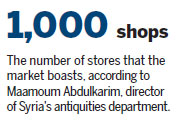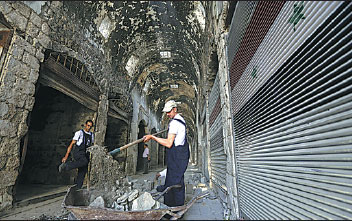Ancient market being restored in war-torn Homs
In the heart of the Syrian city of Homs, workers clear rubble and clean the blackened walls of the war-ravaged old market in a bid to restore its former glory.
Much of Homs lay in ruins when its Old City was recaptured from rebels by government troops in 2014 after a two-year siege and near-daily bombardment.
Now a United Nations-backed project is trying to restore the ancient souk, or market, in the central city, dubbed the "capital of the revolution" because of anti-government protests that erupted there five years ago.
Near Clock Square, where the front-line ran during the fighting, engineers inspect leaking pipes with electrical wires dangling overhead.
Built in the 13th Century under the Ayyubid dynasty founded by legendary Muslim ruler Saladin, the market was further developed during the Mamluk era and Ottoman rule.

It was seized by rebels in 2012, and retaken by the army in 2014, under a deal which saw opposition forces quit Homs and calm return to most of the city.
"The armed men used it as a transit point more than a battlefield, which is why the souk isn't more badly damaged," a government official said.
Homs's souk is similar to the famed ancient markets of Damascus and Aleppo, though much smaller, with around 1,000 shops, according to Maamoum Abdulkarim, director of Syria's antiquities department.
It is just one of many historic sites in Syria that have been damaged or destroyed in the conflict that has killed more than 290,000 people and displaced over half the population.
The majority of the souk's shops are abandoned for now, with some missing locks or doors, while the walls of others have been blackened by fire or pockmarked by shrapnel or bullets.
"Forty years ago, it was the equivalent of the Champs-Elysees for a small town. You could find everyone there. It was where you found all those who specialized ... in wood, copper, silver, fabric merchants, perfume sellers," recalled Anis Nacrour, the former EU representative in Damascus, who is originally from Homs.
"In the evening, coming back from school, we'd pass through just to breathe the air, especially as there were excellent sweet shops and delicious fresh fruit juice stands," Nacrour said.
"We'd go in a group or with family to see and be seen," the French diplomat said.
Now though, some of the market's alleyways are blocked with rubble, and in others weeds are pushing up through the destroyed pavement.
|
Members of the United Nations Development Program work in a damaged alley of the ancient market in Homs last month. Louai Beshara / Agence Francepresse |
(China Daily 09/07/2016 page11)















